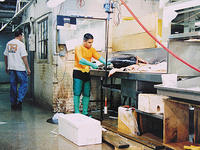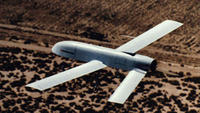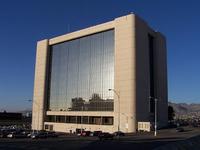-
Coalition of Tucson businesses launches campaign against Arizona harsh immigration law
A coalition of 90 Tucson, Arizona businesses launches a “We Mean Business” campaign to show their resistance to SB 1070 — the harsh immigration law set to take effect 29 July; many of the owners agree there is a need for immigration reform; however they do not think the new law is the most effective approach
-
-
Second drug submersible seized
Colombia’s drug cartels frequently use semi-submersible vessels to smuggle large amounts of cocaine past American and Colombian patrol boats to Central America en route to the United States; law enforcement discovers and seizes second submersible in as many weeks: the first was seized in Ecuador, the second in Guatemala
-
-
U.S. replaces noisy immigration raids at place of employment with "silent audits"
The Obama administration has replaced noisy, media-covered immigration raids at factories and farms with a quieter enforcement strategy: sending federal agents to scour companies’ records for illegal immigrant workers; one expert says: “Instead of hundreds of agents going after one company, now one agent can go after hundreds of companies”; employers say the Obama administration is leaving them short of labor for some low-wage work, conducting silent raids but offering no new legal immigrant laborers in occupations, like farm work; federal labor officials estimate that more than 60 percent of farm workers in the United States are illegal immigrants
-
-
ICE activates Secure Communities in ten more west Texas counties
Secure Communities uses biometrics to prioritize immigration enforcement actions against convicted criminal aliens; with the addition of ten new Texas counties, all eighteen westernmost counties of Texas are currently using Secure Communities
-
-
U.S. economy influences immigration more than security measures

A Forbes’ columnist says that immigrants — legal and illegal — are an economic bellwether, and that recent rends in immigration show that both the low-skilled and high-skilled immigrants have doubts about the U.S. economy right now; a DHS study shows that overall population of unauthorized aliens in the United States dropped from 11.8 million in 2007 to 10.8 million in 2009, in parallel with the economic slow-down; the risk to U.S. national security and economic welfare are these: low-skilled immigrants will likely return when the U.S. economy picks up again, but to bring back high-skilled immigrants, America’s economy will have to do more than make a comeback — it will have to make a strong comeback
-
-
Immigration control at Welsh ports "risks U.K. security"
Immigration control at some of Wales’s ports is “limited” and jeopardizing the U.K.’s border security, says a watchdog; Holyhead seaport, for example, has no permanent immigration controls
-
-
Degree of illegal immigrants' involvement in smuggling drugs, other crimes uncertain
There are about 500,000 illegal immigrants living in Arizona; Governor Jan Brewer’s recently said that the majority of them are “drug mules” and linked them to beheadings; exploring any link between illegal immigration and other crimes is difficult, however, and there is little in the way of reliable data that indicate what crimes immigrants may commit after crossing the border illegally
-
-
U.S., U.K. military leaders address climate change's role as a global threat multiplier
Conflict brought on by droughts, famine, and unwelcome migration are as old as history itself. Yet, a growing number of military analysts think that climate change will exacerbate these problems worldwide and are encouraging countries to prepare to maintain order even as shrinking resources make their citizens more desperate; Rear Admiral Neil Morisetti: “We see climate change as a threat multiplier, as a catalyst for conflict”
-
-
Obama administration sues Arizona over strict new immigration law
The Department of Justice filed a lawsuit in federal court in Arizona, asking for an injunction to prevent the state’s strict new immigration law from taking effect on 29 July; the administration argued the Arizona law, which requires state and local police to investigate the immigration status of anyone they reasonably suspect of being an illegal immigrant, is unconstitutional and would sap law enforcement resources; the lawsuit is part of a broader approach by President Barack Obama to deal with the 10.8 million illegal immigrants believed to be in the country, arguing that immigration is the responsibility of the federal government not each state; “Seeking to address the issue through a patchwork of state laws will only create more problems than it solves,” U.S. Attorney General Eric Holder, said in a statement
-
-
Lawmakers, DHS look for new border security technologies, fresh approach

With SBInet likely to be cancelled (one lawmaker notes that at the current pace of deployment, SBInet would take 323 years to deploy across the 2,000-mile Southwest border — to say nothing of the effectiveness of the project’s technology), the search is on for new border security technologies; DHS is ramping up a program that will explore new public and private sector technologies that could be deployed along the border ; there are plans to develop a system that will link information systems of state, local, and tribal law enforcement entities along the border with those at DHS and the Justice Department; enhance analytic capabilities of fusion centers; and establish a suspicious activities reporting program
-
-
DHS officials meet skeptical reception at Aspen forum on state of U.S.-Mexico border
Reporter writes that there were audible murmurs of disbelief from the audience when Deputy Secretary of Homeland Security Jane Holl Lute noted that her boss, DHS secretary Janet Napolitano, has said “many, many times, the southern border has never been more secure than it is today”
-
-
Bullets fired from Mexico strike El Paso, Texas, city hall

The trend of criminal activity in Mexico spilling into the United States is steadily increasing — but this is new: seven bullets struck the ninth-floor office of Assistant City Manager Pat Adauto on the west side of the El Paso City Hall building; the gunfire may have been stray shots from Juarez, Mexico, on the other side of the border, police said; one of the bullets came through the wall and knocked over a picture frame; one city official: “Now that something like this has happened we’ll put in place more formal procedures so that if something like this occurs again we can have a major notification quickly throughout the building so people can move away from the windows”
-
-
Obama to deliver major speech on immigration today
In his first major speech on immigration since taking office, Obama hopes to rally new momentum behind the push for an immigration overhaul by explaining why he thinks a comprehensive approach is the only way to fix what he and others say is a system badly in need of repair
-
-
Arizona to release immigration training plan for police officers
The tough Arizona immigration law will take effect on 29 July; Arizona officials will today release a training program designed to teach police officers to enforce the crackdown on illegal immigration without racially profiling; an hour-long video and supporting paperwork will be sent to all 170 Arizona police agencies and publicly released
-
-
U.S. has no plan to keep nuclear bomb materials from crossing border
In 2006 the George W. Bush administration announced a $1.2 billion project to deploy thousands of scanners for screening vehicles and cargo at U.S. ports to block the importation of radioactive materials that could be used to make a bomb to protect the United States; the scanners — known as the advanced spectroscopic portal (ASP) machines — proved a failure, and in February, following one setback after another, officials abandoned full-scale deployment of the machines; GAO says that the attention and resources invested in the ill-fated ASPs delayed the creation of a “global nuclear detection architecture” to protect the United States
-
More headlines
The long view
The “Invasion” Invention: The Far Right’s Long Legal Battle to Make Immigrants the Enemy
The Trump administration is using the claim that immigrants have “invaded” the country to justify possibly suspending habeas corpus, part of the constitutional right to due process. A faction of the far right has been building this case for years.
